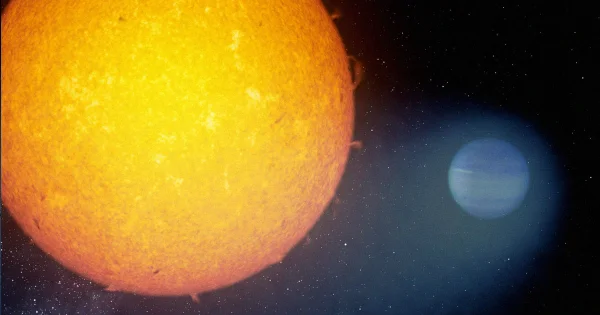Astronomers have stumbled upon a celestial oddity in the form of a peculiar exoplanet with a 350,000-mile-long helium gas tail. This enigmatic world, known as WASP-69b, dances around its star 160 light-years away at a dizzying pace, completing an orbit in a mere 3.9 Earth days. What sets this planet apart is the presence of a tail so long that it stretches one and a half times the distance from our Earth to the Moon. Imagine that – a planet with a tail longer than a Monday morning meeting.
This discovery has roused the scientific community, prompting a flurry of speculation and inquiry. One theory posits that the planet’s tail is the handiwork of an excessively powerful stellar wind, shaping and molding it much like a cosmic sculptor crafting a comet. It’s a cosmic ballet, where the planet and its star engage in an intricate, albeit deadly, dance. The astronomers are also scratching their heads over the peculiar absence of Neptune-sized objects in similar tight orbits around their parent stars. Could it be that these smaller objects are being bombarded into oblivion by the relentless radiation emanating from their stellar companions? It’s a stellar battle of survival of the fittest, with the smaller objects being tossed around like socks in a cosmic dryer.
Granted, WASP-69b might not be the most hospitable locale for your next vacation, what with its puffy, boiling exterior and a helium tail that puts ponytails to shame. However, this peculiar planet holds the key to unlocking profound insights into the intricate tapestry of exoplanet evolution. It’s a window into the cosmic history of worlds beyond our own, a tantalizing glimpse into the diverse and often bizarre range of planetary phenomena that populate our universe. So, while WASP-69b might not be the poster child for interstellar getaways, it certainly has astronomers across the globe buzzing with excitement.
In the grand scheme of the cosmos, WASP-69b serves as a timely reminder of the infinite wonders that await our discovery. It’s a testament to the boundless ingenuity of the universe, constantly surprising us with its kaleidoscopic array of celestial marvels. As we peer into the heavens, let us not forget that there are countless enigmas yet to unravel, each more perplexing and captivating than the last. And who knows what other cosmic curiosities lurk just beyond the fringes of our understanding, waiting to be unveiled by the intrepid explorers of the cosmos.




 By
By

 By
By
 By
By

 By
By
 By
By
 By
By
 By
By







